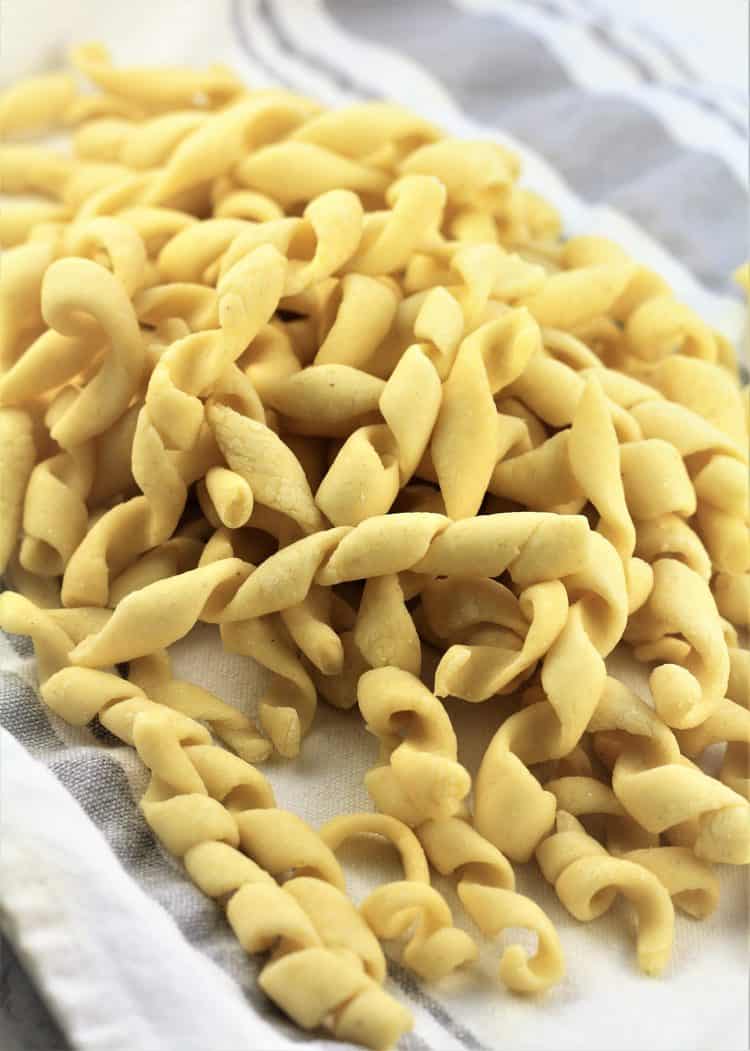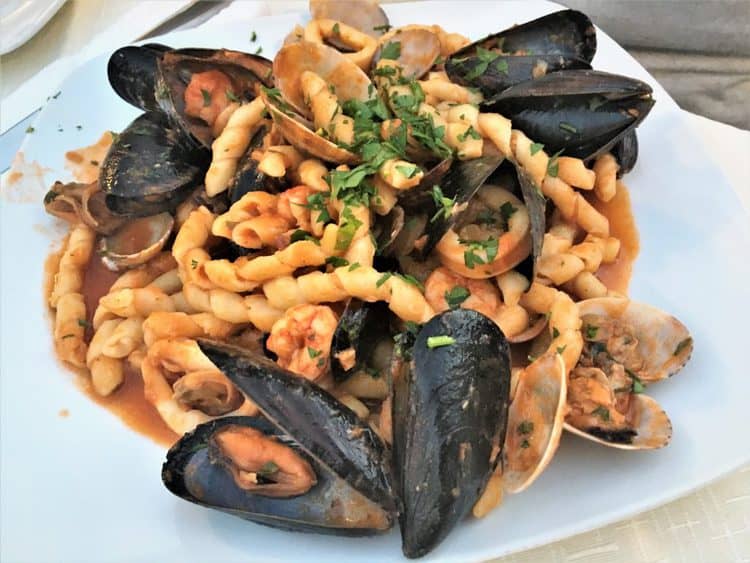Busiate originate from the province of Trapani, located in western Sicily. This telephone cord shaped pasta made of durum semolina flour is traditionally paired with pesto alla Trapanese. Learn to make homemade busiate pasta with my easy step by step instructions with images!

My family and I visited the province of Trapani, in western Sicily, four years ago. I immediately noticed this unusually shaped pasta everywhere we went: in all restaurants, grocery stores and even souvenir shops! Of course we purchased a package to take home with us. There's no doubt about it, busiate are the pasta of choice in this area.
It's always so fascinating to see how specialties vary within Sicily from one province to another. My mother, who originates from the province of Messina, has never heard of nor seen this type of pasta. So, as usual, I decided to do some research about the origins of busiate.

Origin of Busiate:
Busiate are named after the buso, the stem a local grass. The stem of this plant is used to coil the dough around thus giving this pasta it's unique telephone cord shape. Nowadays a thin iron rod, similar to a knitting needle, called a ferretto is used. For this recipe, I used a bamboo skewer.
Busiate are made with two simple ingredients, durum semolina flour and water. This is the same dough used to make cavatelli pasta as well.
Commercially made busiate have a very tight coil which is practically impossible to replicate when making handmade busiate (at least for me it was!). As you can see the curls are more loose but still result in a delicious and pretty looking pasta!

What are busiate served with?
The traditional pairing for this pasta is pesto Trapanese and you'll often find busiate trapanese on restaurant menus in Trapani. This delicious pesto combines cherry tomatoes, almonds (or sometimes pine nuts), basil, garlic and olive oil. Here is that recipe as well!
Busiate is also delicious with other types of pesto such as: traditional basil pesto or pistachio pesto. And of course, you can always serve it with your basic tomato sauce.
We also enjoyed this beautiful plate busiate with a seafood sauce while visiting Trapani. Here's my seafood pasta recipe for you to check out!

Step by Step Instructions:
Combine semolina flour and salt in a large bowl (1). Bring 1 ¼ cups of water to a boil. Make a well in the center and pour in 1 cup of the boiled water (2). Begin stirring the water, gradually incorporating the semolina flour until a shaggy dough is formed (3). If needed, add additional water 1 tablespoon at a time.
At this point, the dough will be warm but easily handled. Gather the pieces of dough with your hands (4) to shape into a ball. Transfer the dough to your counter and knead until a smooth dough is formed, about 5 minutes. The dough will be slightly tacky but not sticky.
Cover with plastic wrap and lest rest for 1 hour. Cut the rested dough into 8 pieces as it easier to work with a smaller piece of dough.
To shape the busiate:
Roll 1 piece of a dough at a time (keeping the remaining dough covered in order to prevent it from drying out) into a long thin rope of about ½ cm diameter.

Cut each rope into 15 cm (6 inch) pieces. Place the dough in a vertical position facing you. Place a bamboo skewer at the top end of the dough at a 45 degree angle. Wrap the tip of the dough around the skewer and coil the dough around the skewer using your left hand to roll the skewer down toward you.
Here's a slow, step by step video to show you how it's done!
Remove the skewer from the pasta. If it is difficult to remove, simply twist the skewer gently in the opposite direction in which you rolled it to loosen the dough.

Place the busiate on a parchment paper or clean dish towel covered tray dusted with flour. Continue with the remaining dough.

To cook busiate
Bring a large pot of water to a boil, add salt and cook busiate for 5-7 minutes until al dente. Serve with your favorite sauce.
Tips and suggestions
Making busiate does take some patience, however with a bit of practice you'll be able to make this beautiful pasta. Here are a few helpful tips:
- If you're making busiate for the first time and rolling them is challenging (as it was for me!), cut smaller lengths of dough to make the rolling process easier.
- When detaching the skewer from the rolled busiate, it may occasionally stick to it. Gently roll the skewer in the opposite direction in which you rolled the pasta to help slide it off.
- Cooking time may vary according to the thickness of your busiate. I rolled my dough into very thin ropes of ½ cm diameter. If your ropes of dough are wider, this will result in a thicker pasta which will take longer to boil and will have a chewier texture.
- Busiate can be frozen. Place the filled trays with busiate in a single layer in the freezer. Once they are completely frozen, transfer to a freezer bag and store up to 3 months.
If you can't get to Sicily to try this delicious pasta, bring Sicily home to you by making your own homemade busiate! Let me know how much you enjoyed them by rating this recipe in the recipe card below. Feel free to Pin the recipe for later. Buon appetito!

Homemade Busiate Pasta Recipe
Ingredients
- 2 ½ cups semolina flour
- 1- 1 ¼ cups water
- 1 teaspoon salt
Instructions
For the dough
- Place semolina flour in a bowl or in a mound directly on your work surface. I prefer starting off my dough in a bowl and once the dough starts to take shape, I transfer it to my counter in order to knead it. Stir salt into the flour.
- Bring 1 ¼ cups of water to a boil. Make a well in the center of the semolina and pour in 1 cup of boiled water.
- Use a fork or wooden spoon to begin combining the semolina flour with the water. Use your hands to gather the crumbly bits to shape into a dough. The dough will be very crumbly and grainy.
- Transfer to a work surface and knead until a smooth dough is formed. This will take about 5 minutes. The dough must be neither sticky nor too dry and should feel slightly tacky. If it is too dry, add a spoonful of the remaining water at a time, as needed. Wrap in plastic wrap and set on your counter to rest for 1 hour.
To shape the busiate
- Divide the dough into 8 pieces. It is easier to roll a smaller portion of dough at a time. Keep the remaining dough wrapped in order to prevent it from drying out.
- Roll each piece of dough into a long rope of about ½ cm thick. Cut into 15 cm (6 inch) pieces.
- Place the strip of dough in a vertical postion facing you. Place a skewer at the top end of the dough at a 45 degree angle facing downward. Wrap the tip of the dough around the skewer. Use your left hand (if right handed) to carefully roll the skewer toward you, coiling the dough around it as you roll.
- Place the busiate on a parchment paper or dish cloth covered tray dusted with flour. Continue with the remaining dough.
To cook
- Bring a large pot of salted water to a boil. Cook the busiate until al dente, about 5-7 minutes. This may vary according to the thickness of your dough.
Notes
- If you're making busiate for the first time and rolling them is challenging (as it was for me!), cut smaller lengths of dough to make the rolling process easier.
- When detaching the skewer from the rolled busiate, it may occasionally stick to it. Gently roll the skewer in the opposite direction in which you rolled the pasta to help slide it off.
- Cooking time may vary according to the thickness of your busiate. I rolled my dough into very thin ropes of ½ cm diameter. If your ropes of dough are wider, this will result in a thicker pasta which will take longer to boil and will have a chewier texture.
- Busiate can be frozen. Place the filled trays with busiate in a single layer in the freezer. Once they are completely frozen, transfer to a freezer bag and store up to 3 months.
- Please note that that nutritional information provided is approximate and may vary according to exact ingredients used and portion size.
Nutrition
We are a participant in the Amazon Services LLC Associates Program, an affiliate advertising program designed to provide a means for us to earn fees by linking to Amazon.com and affiliated sites.
 Bellino Durum Wheat Semolin...Shop on Amazon
Bellino Durum Wheat Semolin...Shop on Amazon






Mark
My new favorite pasta!
Nadia
So glad you enjoyed this recipe Mark, thank you for your comment!
Nancy
I am interested in making this pasta, but what size diameter should the skewer be?
Thank you!
Nancy
Nadia
Hello Nancy, the skewer I used was about 0.5 cm wide. Very similar to a chopstick. Hope this helps!
Nancy
Thank you so much! My skewers are much too small (about 3.2 MM). I'll have to see if I can find some that are thicker.
Thanks again!
Nadia
You're welcome, hope you enjoy them!
Jacqueline Peacock
I am going to try this pasta as I am just back from a trip to Trapani. Hopefully my attempt will so it justice.
Nadia
Hello Jacqueline, I'm sure you had a wonderful time in beautiful Trapani and I hope you enjoy this pasta! It definitely takes practice to roll them just right at first, but after the first few you'll be a pro!
Susan
Can I make it ahead of time and let sit in fridge for a day before cooking?
Nadia
Hi Susan, with most types of pasta I would say no however this pasta made with semolina dries as it sits and therefore there is not much risk for it to stick. I would leave it on a tray in the fridge evenly spaced out. Otherwise you can always freeze it and cook it whenever you need it. Hope this helps, thanks for your question!
Marisa
I’m so loving this pasta shape Nadia and it looks like a must try! Beautifully done too!
Nadia
Thank you Marisa! They are a bit challenging to roll at first but once you get the hang of it it goes rather quickly.
Annie
Oh this looks fantastic! Thank you Nadia! Can’t wait for the accompanying pesto!
Wow, I am going to use a plastic chop stick to roll!
Nadia
Hello Annie, thank you very much! The pesto recipe will be published this week. Let me know how your rolling goes with the chop stick!